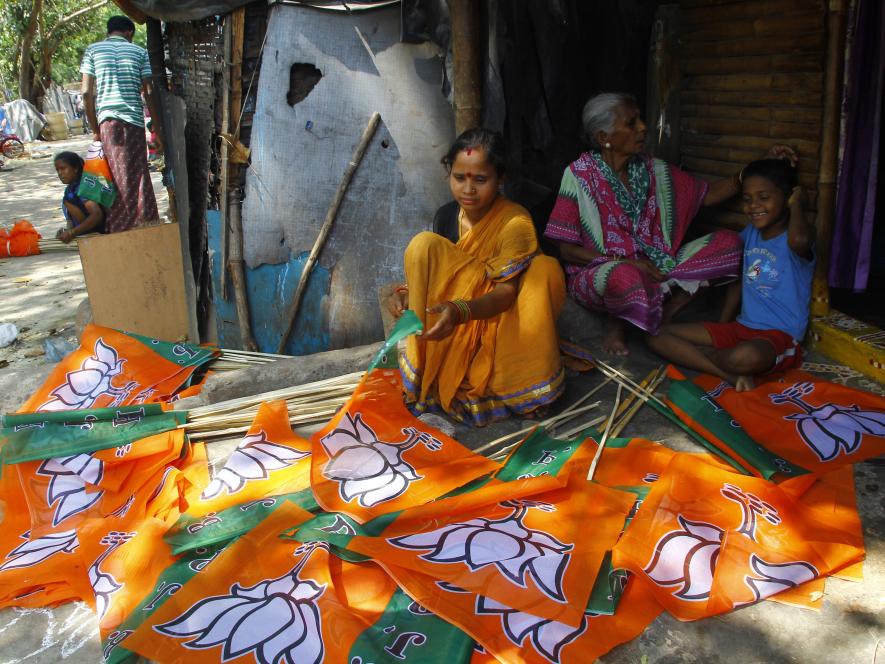What the Changing Face of Telangana Means for BJP

Workers preparing BJP symbol on flag sticks. Representational Image. Image Courtesy: ANI
The Bharatiya Janata Party is making a renewed pitch for Telangana. Unlike its earlier rhetoric centred on Hindu-Muslim polarisation with atrocities committed by the Razakars under the Nizam, it is banking on capturing the imagination centred around big growth, urban infrastructure, expansion of technology and faster business deals. It made a splash with its recent national executive and massive public meetings. The BJP is moving to the centre stage, riding high on the support of the backward classes or OBCs.
In united Andhra Pradesh, the OBCs were with the Telugu Desam Party (TDP), while the Congress essentially was supported by the Dalits, upper castes and the Muslims. With the state’s bifurcation, the Telangana Rashtra Samithi (TRS) had no specific programme for the OBCs, though most backward classes receive benefits from the Rythu Bandhu [farmers friend] schemes and other occupation-based schemes of the State government.
The OBCs are mostly small land owners across the rural hinterlands of Telangana. However, despite the welfare schemes, there seems to be momentum toward the BJP among the OBCs. This, perhaps, has to do with the changing face of rural Telangana and the BJP projecting an OBC leadership in Lok Sabha MP Bandi Sanjay and, more recently, Eatala Rajender joining the BJP.
Eatala Rajender was dropped from the Cabinet on allegations of land encroachment but returned to the Assembly barely five months later, having won a heated by-poll contest in Huzurabad. He emerged as the voice of dissent and became the face of OBC leadership in the state. The TRS came across as a party of dominant castes such as the Velamas. Here, in the popular imagination, the leadership style of K Chandrashekar Rao or KCR was reminiscent of an old-style feudal era, especially his arrogance in handling party affairs.
Two constant sources of income for the state exchequer are land and liquor. The state has actively encouraged the conversion of farmland into real estate for non-agricultural purposes with the passing of the Telangana Agricultural Land Conversion Bill, 2020. The sustained agrarian crisis has made it additionally lucrative for small farmers, most of whom are the OBCs, to either sell their land holdings or take the initiative to convert farmland into plots for constructing villas. There is a literal windfall and expansion of the rent-seeking economy. The speculative character of land deals and real estate has also significantly transformed living conditions, consumption patterns and modes of aspirations and expectations. It is an overnight transformation that one experiences with heavy investments and purchase of agricultural land by big business houses—a shift from subsistence living to conspicuous consumption that includes higher-end mobiles, luxury cars, villas, and tourism.
Consider, for instance, one acre of land within a hundred-kilometre radius around the capital city of Hyderabad. It could cost anywhere between Rs. 80 lakhs to Rs. 1 crore. Even if you are a small farmer owning two acres of land, you could make a massive gain. The cost of one acre of land outside the 100-kilometre radius is anywhere between Rs. 50 lakh and upwards. While farmland closer to Hyderabad city is converted to real estate plots for residences, villas, and small-scale industries, the land beyond the 100-kilometre radius is converted either into farmhouses, gated communities or purchased as a secure investment for future sale. Most of such land is bought by professionals, businessmen, city dwellers, IT sector employees, and NRIs.
Consider some cases to understand the nature of transformation and its impact on social life and politics. Jangaiyya was a landless labourer from the Mudiraj caste, an OBC from a village about 50 kilometres from Hyderabad. About 15 years back, he was grazing cattle and doing farm-related manual labour. He moved to Hyderabad to work as a server in a small hotel. He developed contacts with local business people, mostly Marwaris, who owned jewellery shops or engaged in wholesale spices and lentil business. At their insistence, he began to assist them using his local contacts in the village to purchase agricultural land. He began to earn commission on the sale and purchase of land. Land prices shot up with the construction of an international airport, and Jangaiyya started to sell and purchase land himself. Today, he owns three huge buildings and residential complexes in the nearby town and makes a comfortable living by collecting rents and letting out his property.
There are many such cases. During my conversations with some people, they pointed out that most of those who are middlemen for the real estate transactions belong to the OBC community. One of the reasons they cited was their preparedness to engage in physical violence and offer security to the purchased land. Violence, political clout, and corrupting government officials, including the local police, are routine.
Most business people who buy large chunks of land need physical protection for their properties. It means members of some caste groups on the lower end are much in demand. One told me how he got his son trained as a black belt in karate. Others like the famous Hyderabad pehelwan with a history of violence (and a noted history-sheeter) helps deal with land caught up in court cases. Apparently, he can get land plots vacated and also illegally occupy them. There is the case of Anjaih, again an OBC, who extends similar ‘services’. There are many cases dealing with temple lands—lands donated to local temples—today occupied by those who can use violence and are connected to local politicians. Such henchmen double up in disciplining the labourers engaged by local industries. Most of the labourers are from states like Bihar and Jharkhand. According to some reports, these transactions are gradually being patronised by “Hindu” organisations.
Using religion provides additional security in illegal dealings and using force and violence. Many noted henchmen have shifted their allegiance to the local religious and cultural organisations. There is a formidable nexus between real estate deals, physical violence and religious symbolism. It is a commonplace occurrence to find henchmen sporting tilaks and active in organising religious festivals such as Hanuman Jayanti and Ganesh Chaturthi. Again, bringing in aggressive cultural mobilisation seems to converge with the aggression necessary in handling land deals and para-legal transactions.
Most small farmers today sell land to move to nearby towns and cities in search of a secure income, English education for children and better health facilities. According to one estimate, 3.42 lakh acres of agricultural land within a 100-kilometre radius has been converted into real estate. It is mainly the old, some small farmers and the landless Dalits who have remained in villages. Most people who want better roads and infrastructure reach the nearest town. Significant development, speculative land deals, fast-paced mobility, and rags to riches stories dominate the narrative of the rural hinterlands of Telangana. The poor are being taken care of by state welfare policies, including MGNREGA, pension schemes, free rice, and ration. It is to this changing face that the BJP is attempting to appeal by promising even faster growth and quicker mobility. With no other imagination in sight, one has to wait and watch how regional parties banking on transactional welfarism, subsistence living, and caste-based policies appeal to the changing images. They come across as relatively smaller and slower.
The energy, scale, speed, level of big talk, and connection with the central government and its development plans (like building roads and other infrastructure) provide an entry point to parties such as the BJP, apart from the local reality of how religious symbolism playing an instrumental role beyond religiosity. Prime Minister Narendra Modi’s tempered speech at a public meeting at Parade Grounds seems to be an attempt to connect to this underlying imagination. It appears to be a course correction from a high-decibel campaign and the failure to perform in the West Bengal Assembly election.
The author is an associate professor at the Center for Political Studies, Jawaharlal Nehru University. His book, Politics, Ethics and Emotions in ‘New India’, will be published by Routledge, London, in 2022. The views are personal.
Get the latest reports & analysis with people's perspective on Protests, movements & deep analytical videos, discussions of the current affairs in your Telegram app. Subscribe to NewsClick's Telegram channel & get Real-Time updates on stories, as they get published on our website.
























